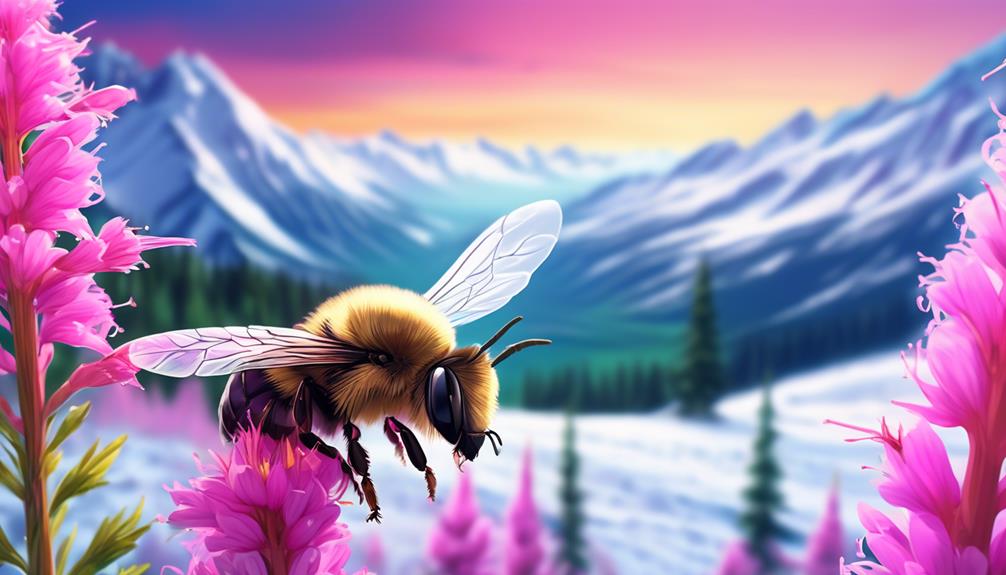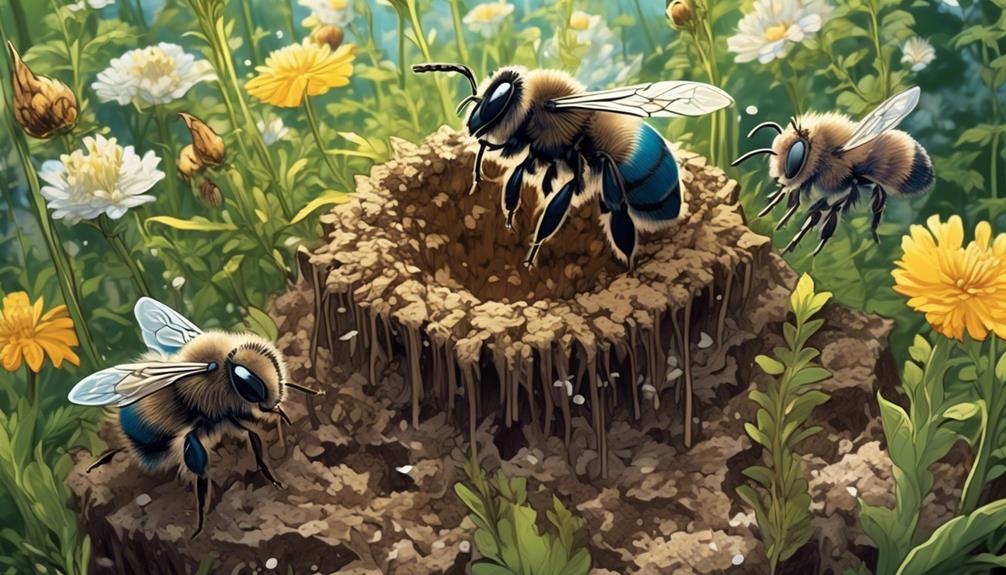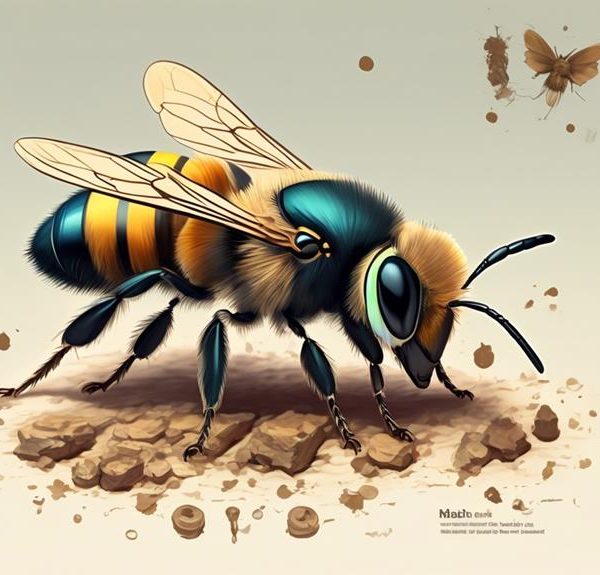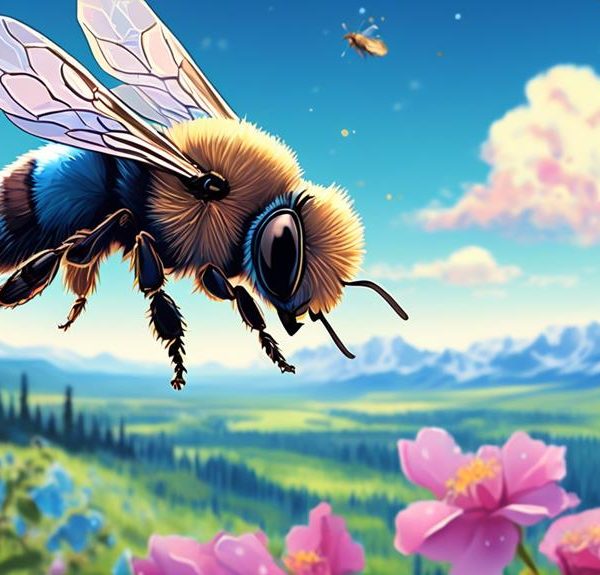Brimming with surprising truths, dive into the intriguing world of mason bees and their unexpected presence in Alaska's unique ecosystem.

Are There Mason Bees in Alaska?
You've probably heard the saying, 'as busy as a bee,' right? Well, when it comes to the world of bees, not all are created equal. Some, like the mason bee, are solitary creatures with fascinating behaviors and habitats.
Now, you're probably wondering if these unique insects can survive in Alaska's harsh climate. After all, Alaska is not exactly known for its warm, sunny days. But before we jump to conclusions, let's first take a closer look at the mason bee, its preferred environments, and the peculiarities of Alaska's ecosystem – an exploration that may just surprise you.
Key Takeaways
- Mason Bees are solitary creatures that can adapt to frigid climates, making them integral to Alaska's ecosystem.
- They are superior pollinators due to their hairy bodies and are more cold-tolerant than most bees.
- Mason Bees prefer to nest in pre-existing holes in wood and can be found in both urban and rural areas as long as there are sufficient resources.
- Their presence in Alaska is vital for the pollination of native plants, contributing to overall biodiversity and ecosystem health.
Understanding Mason Bees

To fully appreciate the importance of Mason Bees in Alaska, it's essential to delve into their unique biological features and ecological roles. Belonging to the genus Osmia, these solitary bees are known for their uncanny ability to adapt to frigid climates, making them integral to Alaska's ecosystem.
Unlike social bees, you'll find that Mason Bees prefer solitude, with females making their nests in small, isolated cavities instead of large hives. They're named 'Mason' due to their habit of using mud or other malleable materials to construct their nests. Your understanding of their vital role in pollination can't be overstated. In fact, they're known as superior pollinators due to their hairy bodies which easily pick up and distribute pollen.
You might be intrigued to learn that, despite their small size, Mason Bees are more cold-tolerant than most bees. This trait allows them to thrive in Alaska's harsh winters where other species fail. Their resilience, coupled with their pollination efficiency, makes them a critical player in Alaska's ecosystem.
Mason Bees' Preferred Habitat

Understanding the preferred habitat of Mason Bees gives you insight into their survival strategies and adaptability in Alaskan environments. These industrious insects are solitary and prefer to nest in pre-existing holes in wood, unlike their honeybee counterparts. They've adapted to a wide range of environments but have certain habitat preferences.
Habitat Feature | Preference | Reason |
|---|---|---|
Nesting Sites | Pre-existing holes in wood | Easier to secure and lay eggs |
Environment | Wide range | Highly adaptable |
Food Source | Flowering plants | Depend on nectar and pollen |
Mason bees are less picky about their surroundings compared to other bees. They're found in both urban and rural areas, as long as there are sufficient resources. They need flowering plants for nourishment, and suitable nesting sites. They're also tolerant of the cold, a trait that allows them to thrive in Alaska's harsh climate.
Overview of Alaska's Climate

Diving into Alaska's climate, you'll quickly notice its distinct extremity, shaped by long, bitterly cold winters and short, mild summers – a unique environment that Mason bees have astonishingly adapted to. The state's climate is predominantly subarctic, with the far north experiencing polar conditions.
There's a considerable variation in temperature and precipitation across Alaska, largely due to its vast size and diverse topography. Coastal regions, for example, experience milder winters and cooler summers with heavy rainfall due to the moderating influence of the ocean. The interior, on the other hand, sees more extreme temperatures, with lows plummeting well below freezing in winter, and highs reaching into the 80s in summer.
The short but intense Alaskan summer provides a vital window for Mason bees. You'll find these industrious creatures taking full advantage of the brief period of warm weather, busily pollinating plants and laying the groundwork for the next generation. Despite the challenging environment, these hardy insects thrive, demonstrating a remarkable adaptation to the state's harsh climate.
Understanding Alaska's climate is essential to fully appreciating the resilience and adaptability of Mason bees in this region.
Studying Alaskan Bee Populations

When you delve into the study of Alaskan bee populations, you'll find a remarkable diversity, including the resilient Mason bees, whose survival strategies are intricately shaped by the state's extreme climate. These bees, specifically the Osmia lignaria species, have adapted to Alaska's harsh, frigid winters and short, intense summers. Their hardiness allows them to thrive where other species can't.
You'd also discover the critical role Mason bees play in Alaska's ecosystem. They're known for their superior pollination abilities, outperforming even the renowned honeybee. Due to their solitary nature, each female is a queen, laying eggs and provisioning her own nest. This makes them less vulnerable to diseases and parasites that plague hive-dwelling bees.
Researchers capture and study these bees, examining their behavior, diet, and environmental preferences. They're also scrutinized for their reactions to climate change, as shifts in temperature and precipitation patterns can significantly impact their lifecycle.
Your understanding of Alaska's bee populations wouldn't be complete without acknowledging the threats they face. Pesticide exposure, habitat loss, and invasive species are continual challenges. Yet, despite these obstacles, the Mason bees' resilience offers hope and fascinating insights into survival in an extreme environment.
The Presence of Mason Bees in Alaska

Building on the importance of Mason bees in Alaska's ecosystem, let's now explore their actual presence and distribution across the state. You might be surprised to learn that these industrious pollinators are indeed found in Alaska, particularly in the southern and southeastern regions where the climate is milder.
Detailed studies have found that Mason bees thrive in the diverse Alaskan landscapes, from the coastal areas to the deciduous and coniferous forests. They're attracted to the abundant flora such as fireweed, wild roses, and raspberry blooms, which they use for nectar and pollen collection.
The Mason bee's range is somewhat limited by Alaska's harsh climate, especially in the northern and western regions. However, their adaptability allows them to survive in a variety of habitats. They've been observed nesting in pre-existing holes in wood or in the ground, making them extremely resilient.
While the exact population of Mason bees in Alaska isn't well-documented, it's evident they play a crucial role in the local ecosystems. Their presence is vital for the pollination of native plants, contributing to the overall biodiversity and health of these unique environments.
It's clear that Mason bees are a small but significant part of the Alaskan landscape.
Conclusion
So, you've explored mason bees and Alaska's diverse climates.
You've dived into Alaskan bee populations and their unique habitat preferences.
Indeed, mason bees are present in Alaska, but their distribution and population may vary due to the state's diverse climatic conditions.
It's a fascinating intersection of entomology and climatology and a testament to nature's adaptability.
Keep on investigating – who knows what you'll discover next in the world of bees!



